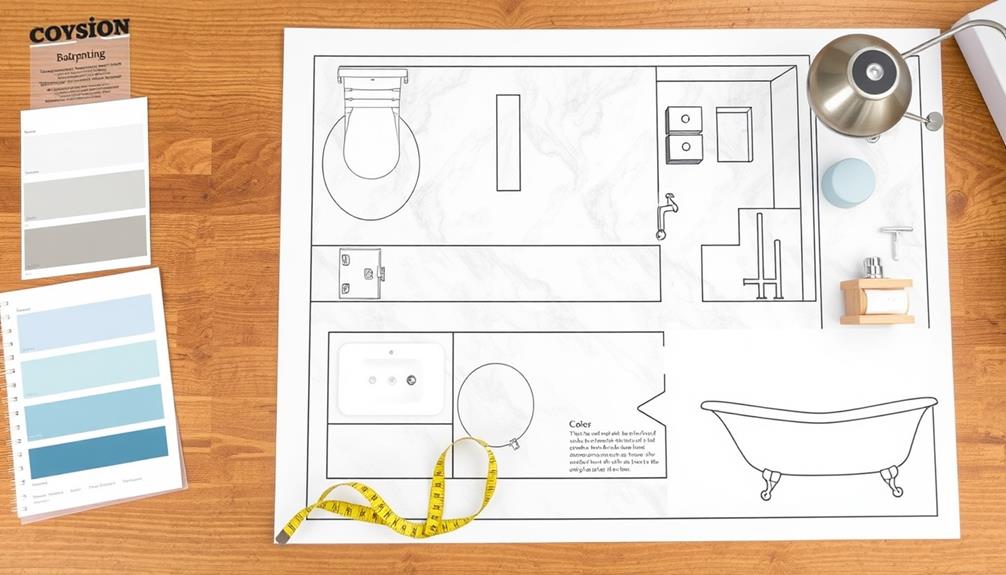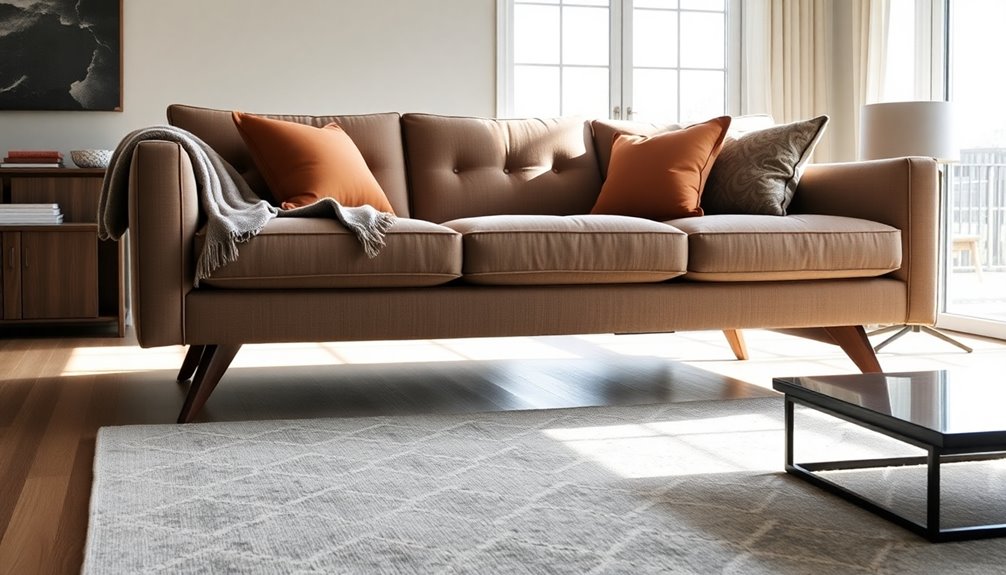To begin planning a bathroom renovation in the United States, it is important to first assess your needs and visualize your perfect space. Determine which fixtures are essential and explore storage solutions for functionality. Create a practical budget that takes into account average expenses and any potential unforeseen costs. Make sure to understand local building codes to ensure compliance, especially when it comes to electrical work. Opt for long-lasting materials and stylish designs that match your personal taste. Lastly, collaborate with experienced professionals to turn your vision into reality, maintaining clear communication throughout the process. By following these steps, you will be well on your way to creating a beautiful bathroom that perfectly fits your lifestyle. There is so much more to discover!
Key Takeaways
- Assess the needs of all bathroom users to determine essential fixtures and desired atmosphere, creating a functional and welcoming space.
- Establish a realistic budget, including material costs and additional expenses, and prioritize key fittings while accounting for unexpected costs.
- Consult local building regulations and obtain necessary permissions to ensure compliance for structural changes and electrical work.
- Choose high-quality and durable materials while considering current design trends and sustainable options for an aesthetically pleasing and eco-friendly bathroom.
- Coordinate with experienced professionals, maintaining clear communication and reviewing contracts to ensure the project runs smoothly and meets expectations.
Assess Your Bathroom Needs
When planning your bathroom remodel, start by evaluating your specific needs and preferences. Identify the primary users of the bathroom, considering family dynamics and guest usage. This’ll help you determine essential fixtures, like bathtubs, sinks, and a walk-in shower. Consider the layout and flow of the space as well, ensuring that the bathroom is both functional and aesthetically pleasing. Additionally, keep in mind any specific accessibility needs for users, such as grab bars or a walk-in tub. These bathroom renovation tips will help guide your decision-making process as you create a design that fits your lifestyle and meets your needs.
Think about the bathroom layout that best suits your lifestyle and daily habits. Additionally, creating a mood board can help you visualize your design ideas and guarantee they align with your functional requirements.
Next, establish the desired atmosphere for your space. Do you want a relaxing sanctuary to unwind after a long day, or do you prefer an energizing environment to kickstart your mornings? These choices will guide your bathroom design and aesthetic preferences.
Don't forget about storage solutions; they're vital for maintaining a tidy and functional space. Engage your family members in discussions about practical needs, making sure everyone's voice is heard.
This collaborative approach will help you create a bathroom that caters to everyone's requirements.
Establish a Realistic Budget
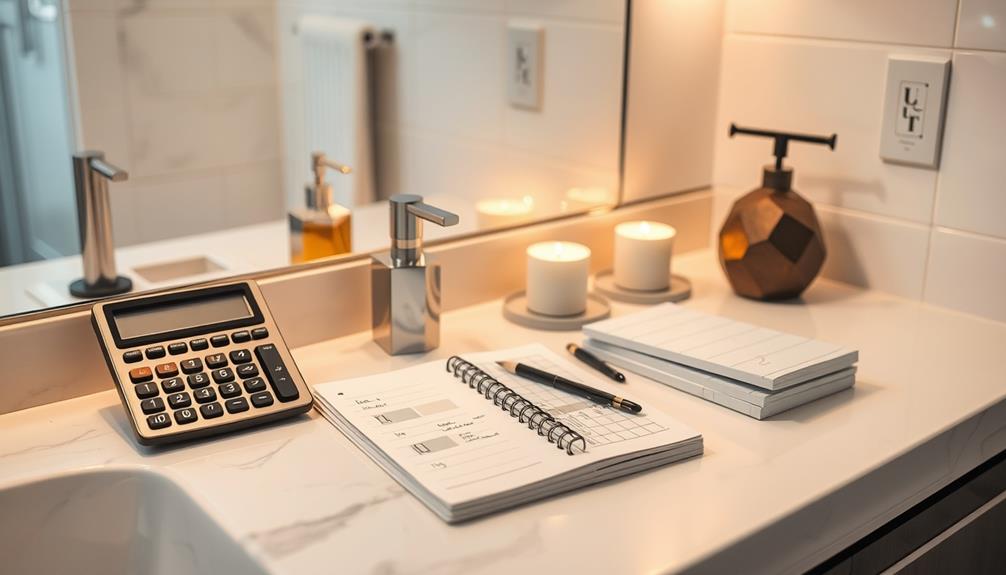
Establishing a realistic budget is essential to the success of your bathroom remodel. Start by considering the average cost for basic new bathroom materials in the UK, which is around £4,500, with installation costs likely matching that figure.
Don't forget to factor in additional expenses for disposing of existing fixtures and fittings, plastering, and decoration, as these can considerably increase your total expenditure. To avoid financial pitfalls, it's important to be aware of common financial terms that can impact your remodeling budget.
To make certain you're not overspending, it's wise to obtain a minimum of three quotes from contractors. This helps you assess costs accurately and make informed decisions.
When you establish a realistic budget, prioritize key bathroom fittings like taps and tiles, while also setting aside funds for unexpected expenses that may crop up during the renovation process.
Creating a detailed budget plan that distinguishes between your wants and needs will streamline your decision-making. Focus on achieving maximum impact with your chosen features while keeping your budget in check.
Understand Building Regulations
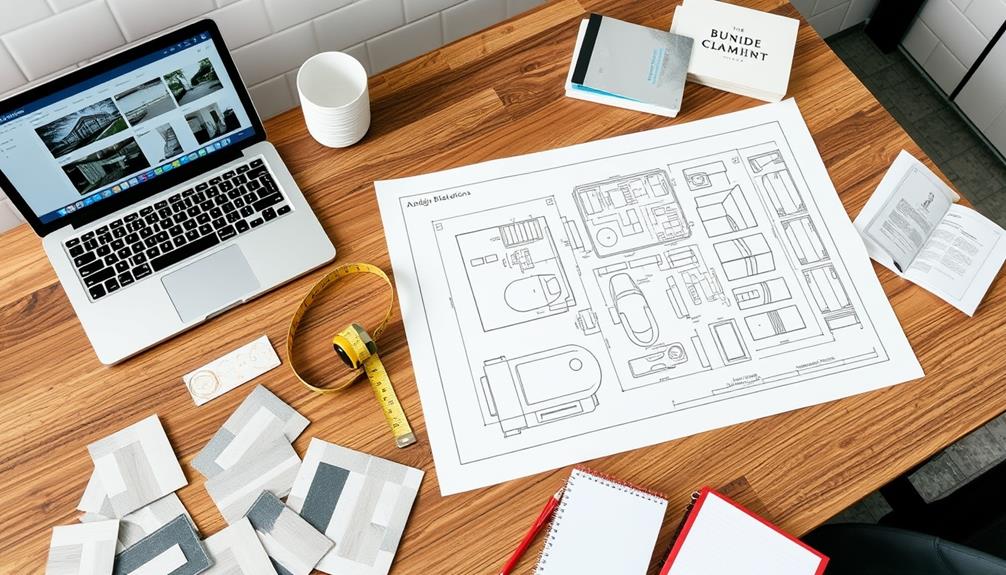
Understanding building regulations is essential for any bathroom remodel. These rules guarantee your renovation meets safety and legal standards.
If you're relocating plumbing, electrical work, or drainage, you'll need to adhere to specific building regulations. Implementing a home security system can also enhance safety during your remodel, as studies show homes without security systems are 300% more likely to be burglarized increased safety and peace of mind.
Here are four key points to take into account:
- Consult Your Local Authority: Before starting, check with your local council about the existing regulations in your area, as they can vary considerably.
- Electrical Work Compliance: Any electrical work near wet areas must comply with Part P of the Building Regulations. Make sure a qualified electrician performs this work, as you'll need certification upon completion.
- Structural Changes: If your renovation involves moving a toilet or installing a new shower, you may need to submit a building notice or full plans for approval from your local authority.
- Planning Permission: For listed properties or those in conservation areas, you might need planning permission to guarantee you comply with heritage preservation standards.
Choose Design and Materials
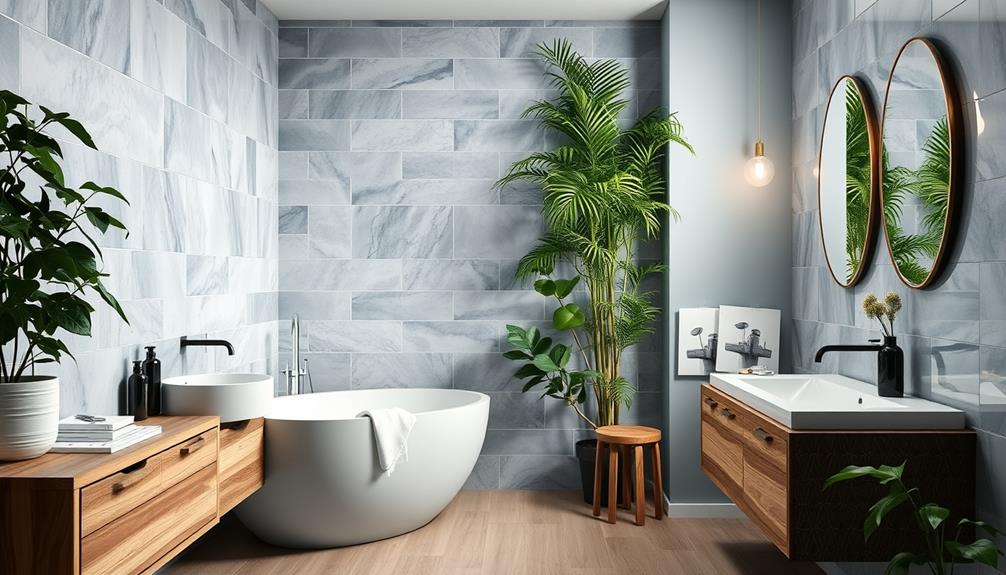
Choosing the right design and materials for your bathroom remodel is essential to create a space that's both functional and visually appealing. Start by selecting high-quality materials, like durable tiles and stylish fixtures and fittings.
The average cost for basic new bathroom materials in the UK is around £4,500, so investing wisely can enhance both aesthetics and longevity. For a modern farmhouse feel, consider key features of a farmhouse bathroom such as a freestanding soaking tub or shaker-style cabinetry.
Explore innovative design trends for 2024, such as geometric tiles or natural materials, to keep your bathroom modern. Don't forget to choose a grout color that complements your existing tiles; a well-selected grout can greatly elevate the overall look.
Incorporating sustainable materials, like reclaimed wood or eco-friendly fixtures, not only adds character but also aligns with today's environmentally conscious trends.
Coordinate With Professionals
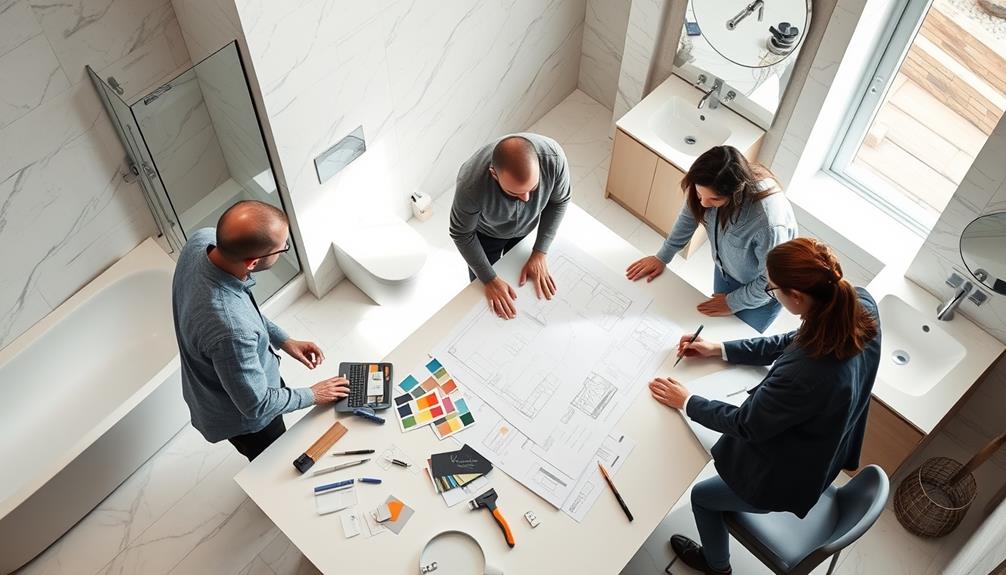
Effective coordination with professionals can make or break your bathroom remodel. Engaging specialists like builders, electricians, and plumbers guarantees your project adheres to building regulations, preventing costly mistakes.
Additionally, understanding the importance of financial planning for your renovation, similar to assisted living expenses, can help you allocate resources effectively.
To achieve a successful renovation, follow these steps:
- Clear Communication: Share your design ideas and preferences with contractors, including details about your shower enclosure and extractor fan. This alignment of expectations is essential.
- Check References: Research contractors' past work to confirm their expertise aligns with your needs, especially if you're working on a top bathroom project.
- Timely Coordination: Hire a senior designer to help streamline the project. They can coordinate first and second fix installations, minimizing the risk of damaging new fixtures.
- Understand Contracts: Read through the terms of contracts and warranties provided by professionals. Knowing these details can lead to cost savings and peace of mind throughout your remodel.
Frequently Asked Questions
In What Order Should You Renovate a Bathroom?
To renovate a bathroom efficiently, start by removing existing fixtures, then install structural elements. Next, focus on plumbing and electrical work before adding key features, tiling, and finally, installing fixtures and decorative elements.
Where Do I Start When Planning a Bathroom Renovation?
To kick things off, you should assess your needs and visualize the atmosphere you want. Measure your space accurately, set a realistic budget, and gather inspiration from showrooms or online platforms to make informed decisions.
In What Order Do You Fit a New Bathroom?
You should fit a new bathroom by starting with the flooring, then install the shower or bathtub, followed by the toilet and sink. Finally, add tiles and finishing touches to complete the look.
What Are the Steps to a Full Bathroom Remodel?
You'll start by evaluating needs and budgets, then design a layout. Next, hire professionals for complex tasks. Finally, follow a systematic process, monitoring timelines to guarantee a smooth and efficient remodel. Enjoy the transformation!
Conclusion
In the end, planning your bathroom remodel is like crafting a fine recipe; you need the right ingredients and a pinch of creativity. Just like a chef wouldn't skip the essential spices, don't overlook the details that make your space uniquely yours. With careful assessment, budgeting, and design choices, you'll create a sanctuary that reflects your style. So roll up your sleeves and start mixing those elements together—your dream bathroom is just a plan away!
